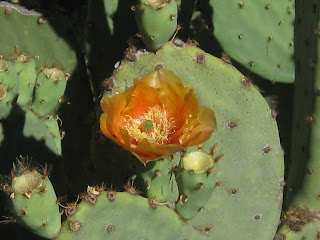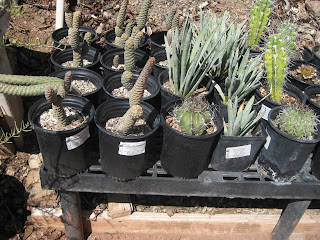During one of our earlier visits to Arizona, my sister introduced us to the Boyce Thompson Arboretum located about and hours drive east of Phoenix in the town of Superior. Now I knew what an arboretum was, having lived in Michigan all my life; however, I was totally unprepared for the depth and beauty found in an arboretum in Arizona! In order for you to understand this incredibly beautiful place, I want to give you a little background. Colonel Boyce Thompson was a significant figure in the early mining expeditions in the area, and several active mines are still found in the area. What is now the Arboretum was at one time the backyard for Col. Thompson's summer home called "Picket Post House". His house still remains and is the site for various fundraisers and special tours during the year. The objective that Col. Thompson had in landscaping his backyard was to showcase plants from all the deserts of the world. Hence, the wide variety of plant materials one will find here.
The two photograph above were taken of plants that are part of the demonstration garden. The aloes blooming in the first picture frame the wall of the entry to this garden. Inside one will find a series of gardens, all of which are possible in a low or mid desert setting. There is much to learn by exploring this area of the Arboretum.
Here Tom stands in front of one of the agave plants found in the Arboretum. Now he is a full 6'2" tall, so you get the feel for the size of this agave. I can assure you that if you come to visit us in our desert home, you will not find an agave of this size in our landscape! But here, it is absolutely magnificent. When in bloom, the flower stalk will tower above this 8'+ plant to a height of at least 15'. |
The photographs above give you an idea of the breathtaking views that visitors find as they wander the Arboretum grounds. No matter how professional a photograph might be, it doesn't begin to do justice to the beauty one experiences on a personal level.
This is a picture of Ayers Lake. I was pretty quiet the day I took this picture, but in the right season it is a very active lake since it is the main body of water in the vicinity. Any visit to the Arboretum always include checking out the lake and what birds are on the water or actively seeking food and shelter in the immediate surroundings.
Pomegranate plants abound at the Arboretum, with an entire hedge of plants enclosing the herb garden. For those of you who are familiar with the Bible, you will find this plant mentioned in various places. Not only is it referred to as a food of the Bible lands, but also was a decorative carving as well as an ornamentation for items of clothing. So I was fascinated to see it growing here and blooming so vigorously. A few months after this picture was taken, I was able to participated in a walk titled "Plants of the Bible" at the Arboretum. It was well worth the time that I spent accompanying the leader and listening to his presentation as we roamed the grounds!
For those of you who know me, you will understand the meaning of this sign. Any time I run across a sign such as this, I immediately begin to pay closer attention than I may have been mere seconds before. The Arboretum is home to many species of birds, including several hummingbird species; but the bird that is celebrated the most is the Turkey Vulture. There are festivals held upon its return and upon its departure from the Arboretum. During the late winter through early fall time period, they can be seen soaring above the hills and washes looking for a meal or snack. Then when it is time to rest, a visitor can observe them perched on the outcroppings of the rocks sunning themselves and getting ready for their next search for food.
With many species and many plants of each cactus species planted around the grounds, spring and early summer brings visitors close-up views of the beautiful flowers displayed on each. The earliest blooms begin in February with some cactus blooming even into the later summer months, especially if there is a good amount of moisture from the monsoons. The second flower is from the Prickly Pear cactus, which is prolific in the Arboretum. The fruits are celebrated with classes instructing visitors and residents how to harvest and use the juice in syrups, jellies, sauces, and so on. Of course, the classes always include samples for the class participants to enjoy!
Our visit to the Arboretum is finished for this time; and as we leave, we find that there is the opportunity to take a part of the desert habitat with us. There are always plants for sale, including many species of cacti such as the ones pictured below. I usually save my purchases for the annual plant sale. My landscape includes a couple of cactus purchased at the annual sale with plans to add more very soon:-)
I trust you have enjoyed this virtual tour of the Boyce Thompson Arboretum. If you ever come to Arizona, and I hope you do, I would be happy to accompany you on the unique experience of exploring this delight in the mid-desert of Arizona. Clouds are gathering over the mountains in the mid-afternoon, so it is time to head for home. I look forward to seeing you on another edition of "Desert Delights".













































